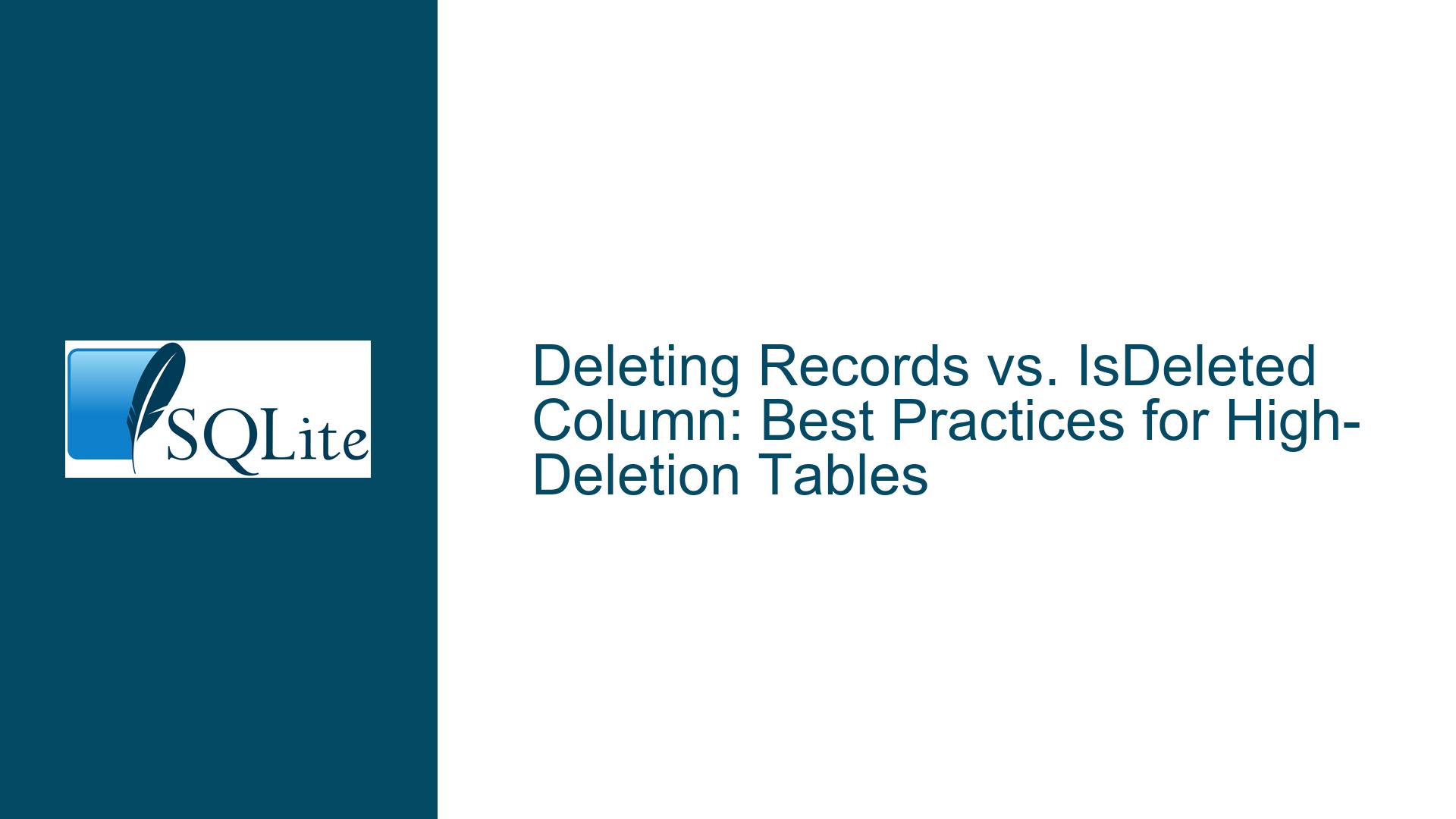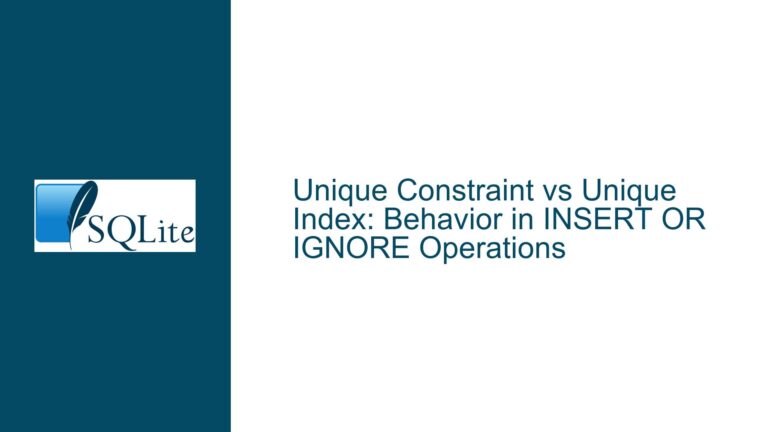Deleting Records vs. IsDeleted Column: Best Practices for High-Deletion Tables
Issue Overview: High-Deletion Tables and Auto-Increment Integer ID Management
In database design, particularly in SQLite, managing tables with a high rate of record deletions presents unique challenges. The core issue revolves around whether to physically delete records from the table or to implement a soft deletion mechanism, such as adding an "IsDeleted" column. Both approaches have implications for database performance, storage efficiency, and future scalability. Additionally, the use of auto-increment INTEGER primary keys introduces concerns about ID exhaustion, especially in high-deletion scenarios where many IDs may be "lost" due to deletions.
When records are physically deleted, the auto-increment mechanism continues to increment the primary key, potentially leading to gaps in the sequence. While SQLite uses a 64-bit integer for auto-increment IDs, which provides an astronomically large keyspace (up to 9.2 quintillion values), the theoretical concern of ID exhaustion remains, albeit practically negligible. However, the more immediate concern is the impact of deletions on query performance, storage fragmentation, and the ability to reconstruct historical data.
On the other hand, implementing an "IsDeleted" column allows for soft deletion, where records are marked as deleted rather than removed from the table. This approach preserves the integrity of the auto-increment sequence and provides the ability to "undelete" records if needed. However, it introduces additional complexity, such as the need to filter out deleted records in queries, increased storage requirements, and potential performance degradation over time as the table grows with both active and deleted records.
The decision between these two approaches depends on several factors, including the nature of the deletions (system-driven vs. user-driven), the need for historical data reconstruction, and the specific performance and storage constraints of the application. For example, if deletions are primarily user-driven, the ability to undo deletions may be a critical requirement. Conversely, if deletions are system-driven and irreversible, physical deletion may be more appropriate.
Possible Causes: Performance, Scalability, and Data Integrity Considerations
The choice between physical deletion and soft deletion is influenced by several underlying factors, each of which can significantly impact the database’s performance, scalability, and data integrity.
1. Performance Impact of Physical Deletion:
Physical deletion of records can lead to fragmentation within the database file, especially in SQLite, which does not automatically reclaim space from deleted records. This fragmentation can degrade query performance over time, as the database engine must navigate through empty or partially filled pages. Additionally, frequent deletions can cause the auto-increment mechanism to generate large gaps in the primary key sequence, which, while not immediately problematic, can lead to inefficiencies in indexing and storage.
2. Storage Overhead of Soft Deletion:
Soft deletion, implemented via an "IsDeleted" column, avoids the fragmentation issues associated with physical deletion but introduces its own set of challenges. As the table grows with both active and deleted records, the storage requirements increase, potentially leading to larger database files and slower query performance. Queries must also include a filter condition to exclude deleted records, which can add overhead, particularly in complex queries or large datasets.
3. Data Integrity and Historical Reconstruction:
One of the key advantages of soft deletion is the ability to maintain a complete history of records, including those that have been deleted. This can be invaluable for debugging, auditing, and compliance purposes. For example, if a user accidentally deletes a record, the ability to "undelete" it can prevent data loss. Similarly, maintaining a history of deletions can help reconstruct the state of the database at a specific point in time, which is often required for troubleshooting or regulatory compliance.
4. Auto-Increment ID Management:
The use of auto-increment INTEGER primary keys introduces a unique challenge in high-deletion scenarios. While the 64-bit keyspace is vast, the continuous incrementing of IDs, even after deletions, can lead to large gaps in the sequence. This is not a practical concern for ID exhaustion but can impact the efficiency of indexing and storage. Additionally, the loss of IDs due to deletions can complicate certain operations, such as generating sequential reports or exporting data.
5. Application-Specific Requirements:
The nature of the application and its specific requirements play a significant role in determining the appropriate deletion strategy. For example, in a messaging application where notifications are frequently deleted, the ability to undo deletions may be less critical than in a financial application where transaction records must be preserved for auditing purposes. Similarly, the frequency and volume of deletions, as well as the expected lifespan of the database, must be considered when choosing between physical and soft deletion.
Troubleshooting Steps, Solutions & Fixes: Optimizing Deletion Strategies for High-Deletion Tables
To address the challenges associated with high-deletion tables in SQLite, several strategies can be employed to optimize performance, maintain data integrity, and ensure scalability. These strategies include a combination of physical and soft deletion techniques, as well as additional optimizations to mitigate the impact of deletions on the database.
1. Implementing a Hybrid Deletion Strategy:
A hybrid approach combines the benefits of both physical and soft deletion. In this strategy, records are initially marked as deleted using an "IsDeleted" column, allowing for the possibility of undoing deletions. After a certain period, such as a week or a month, records that are marked as deleted can be physically removed from the table. This approach provides the flexibility of soft deletion while minimizing the long-term storage overhead.
To implement this strategy, a scheduled task or background process can be used to periodically scan the table for records marked as deleted and physically remove them. This process can be optimized by using batch deletions to reduce overhead and improve performance. Additionally, the "IsDeleted" column can be indexed to speed up the filtering of deleted records in queries.
2. Using Timestamps for Deletion:
Instead of a simple boolean "IsDeleted" column, a timestamp column can be used to record the time at which a record was deleted. This approach provides additional flexibility, such as the ability to implement auto-deletion after a certain period or to allow users to recover deleted records within a specific time window. For example, notifications could be automatically deleted one hour after delivery, while still allowing users to recover them within that hour.
The timestamp approach also facilitates the reconstruction of historical data, as it provides a clear record of when each record was deleted. This can be particularly useful for debugging and auditing purposes. To implement this strategy, queries must be modified to filter out records based on the deletion timestamp, and a background process can be used to physically remove records that have been deleted for a specified period.
3. Leveraging Triggers for Audit Trails:
Another approach is to use triggers to maintain an audit trail of all deletions. In this strategy, a separate table is used to log all deletion events, including the ID of the deleted record and the time of deletion. This allows the original table to be kept clean of deleted records, while still maintaining a complete history of deletions for auditing and debugging purposes.
To implement this strategy, a trigger can be created on the "Notifications" table to automatically insert a record into the audit trail table whenever a record is deleted. The audit trail table can then be used to reconstruct the state of the "Notifications" table at any point in time. This approach provides the benefits of physical deletion while still maintaining the ability to track and recover deleted records.
4. Optimizing Auto-Increment ID Management:
While the risk of ID exhaustion is minimal due to the large keyspace provided by SQLite’s 64-bit integers, there are still steps that can be taken to optimize ID management in high-deletion scenarios. One approach is to periodically reset the auto-increment counter, although this must be done carefully to avoid conflicts with existing records.
Another approach is to use a custom ID generation strategy that recycles deleted IDs. For example, a separate table can be used to track available IDs, and a trigger can be used to assign the next available ID when a new record is inserted. This approach can help reduce the gaps in the ID sequence and improve the efficiency of indexing and storage.
5. Periodic Database Maintenance:
Regular maintenance of the database can help mitigate the impact of deletions on performance and storage. This includes tasks such as vacuuming the database to reclaim space from deleted records, rebuilding indexes to reduce fragmentation, and optimizing queries to minimize the impact of filtering deleted records.
The SQLite VACUUM command can be used to rebuild the database file, reclaiming space from deleted records and reducing fragmentation. This command should be run periodically, particularly in high-deletion scenarios, to maintain optimal performance. Additionally, indexes on the "IsDeleted" column or deletion timestamp can be periodically rebuilt to ensure efficient query performance.
6. Application-Level Considerations:
Finally, the application itself can be designed to minimize the impact of deletions on the database. For example, batch deletions can be used to reduce the overhead of individual delete operations. Similarly, the application can be designed to handle large gaps in the ID sequence gracefully, such as by using a custom ID generation strategy or by avoiding operations that rely on sequential IDs.
In conclusion, the choice between physical deletion and soft deletion in high-deletion tables depends on a variety of factors, including performance, storage, and data integrity requirements. By implementing a hybrid deletion strategy, using timestamps for deletion, leveraging triggers for audit trails, optimizing ID management, performing regular database maintenance, and considering application-level optimizations, it is possible to achieve a balance between these competing demands and ensure the long-term scalability and performance of the database.






